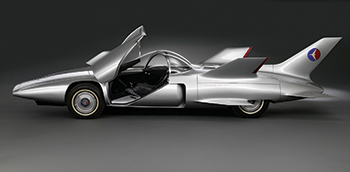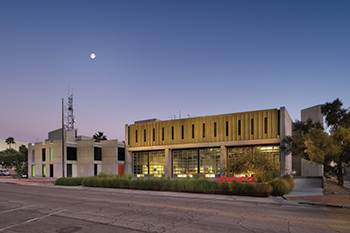Tucson Modernism Week

Photo: On Saturday, October 10, 5pm, join Architect Dino Sakellar (son of Nicholas Sakellar) for an exploration of the life and work of one of Tucson’s iconic mid-century modern architects. The son of Greek emigrants Nicholas and his bride, Phyllis, moved to Tucson soon after World War Two. Over his 50 years of practice he created many of Tucson’s most beautiful buildings. He is one of three architects credited with bringing modern architecture to Tucson.
Exploring Tucson’s Mid-century Design Heritage
After four years, jam-packed schedules and a slew of innovative lectures and events, you’d think the organizers of Tucson Modernism Week might start running out of ideas.
Not so. This year’s Tucson Modernism Week is busier than ever, the line-up arguably its most impressive to date.
That’s due in large part to the small army of volunteers behind the nine-day event. And it’s due in equally large part to the stories that abound here in Tucson, says Demion Clinco, Chief Executive Officer of the Tucson Historic Preservation Foundation, which organizes Tucson Modernism Week.
“I think that Tucson was definitely an epicenter of design in Arizona and regionally and in some ways nationally and we don’t give our community credit for that,” says Clinco. Added to that is the fact that retirees who settle here bring with them their own “incredible” stories, he says.
In fact, the more Clinco and his team digs, the more fascinating tales of mid-20th-century Tucson it uncovers. Some of those stories take longer to emerge than others, however.

1950s western wear dresses by Tucson based Dolores Gonzales (Dolores Resort Wear), a special exhibit of Tucson Modernism Week. Image courtesy of the Dolores Gonzales Family Collection.
Clinco first spotted the 1950s dresses of fashion designer Delores Gonzales in archive materials more than a year ago. It took many months and some detective work to locate her remaining family, now living in Colorado and California. That set in motion the creation of a fashion exhibition of Gonzales’ western wear, to take place in the lobby of the Tucson Convention Center on October 3rd and 4th.
Delores Gonzales was born in Sonora, Mexico in 1907. In 1914, at the age of 7, she moved with her family from Agua Prieta to Douglas, Arizona. The story goes that a bullet from a Pancho Villa raid had landed on Delores’ pillow. Her father said “Enough” and moved the family over the border. Gonzales learned her sewing skills from her mother Beatrice and honed them in Los Angeles where she was a pattern cutter. Bad asthma forced her to return to Tucson where she owned a factory and a store.
“She was quite well known in Tucson and societal circles,” says Bob Gonzales, Delores’ younger son, who with his brother Leo used to roll braid and rick rack in the factory as a child.
She was also influential in the fashion world. “Cele Peterson credited her as being a major component of the whole movement of patio and western dresses,” says Clinco. This “Tucsonan chic” style – which incorporated the colors and Native American influences of the southwest – was picked up by national department stores. Says Clinco: “There’s no one person who you can credit but [Delores] comes as close as you can get.”
“I think that it’s overdue,” says Dolores’ daughter-in-law Karyl Gonzales of the Tucson Modernism Week exhibit. “She more than won any accolade anyone ever gave her.” Karyl, who will attend the event, remembers Dolores as a “party girl, party giver and party goer.” She first set eyes on her future mother-in-law at a function at the Pioneer Hotel on Stone Avenue. “She had white hair pulled back in a bun. She was wearing a black gown. I thought she was the most beautiful woman I had ever seen,” says Karyl.
Karyl married Dolores’ son Leo (known as Lee) and she and Dolores bonded over fashion; Karyl studied theatre at the University of Arizona and went on to work in costuming. Karyl and Lee’s daughter Lisa Marie Gonzales – whose childhood wardrobe was filled with outfits Dolores made just for her – carries on the fashion legacy. Lisa Marie now owns the fashion line DCC Diversified Clothing Company in California.
Fashion is a strong theme of this year’s Tucson Modernism Week. Ted DeGrazia’s textile designs will be on show at the DeGrazia Gallery in the Sun, while the closing party is a 1965 fashion show and silent disco at the 1965-built Murphy Wilmot Library.
Other Tucson Modernism Week highlights include: a furniture and home goods expo at the Tucson Convention Center; a mid-century modern home tour featuring buildings by Arthur Brown, Louis Coon, Nicholas Sakellar and William and Sylvia Wilde (and special lectures on architects Nicolas Sakellar and William and Sylvia Wilde); and the annual vintage trailer show.

Firebird III GM Concept Car. Image courtesy GM Media Archives
One of the stand-out events will take place at MOCA Tucson: the arrival of the Firebird III [see sidebar]. This futuristic concept car was developed by General Motors in the 1950s as part of a series of car designs that were never intended for production, but rather to showcase just how far GM could go with its technology and design.
The car barely leaves its home at the General Motors Heritage Center in Sterling Heights, Michigan. On October 3rd, thanks to a collaboration between Tucson Modernism Week, the General Motors Heritage Center and insurance firm AIG, it will be on display for one weekend only at MOCA. Also present will be two of its designers, Norm James and Tucsonan Jim Ewen – reunited for the first time in more than 50 years.
The significance of the Firebird’s journey to Tucson isn’t lost on Thom Sherwood, a local Pontiac enthusiast and volunteer for Tucson Modernism Week. “It’s as if someone were to ask the Louvre in Paris to send the Mona Lisa to a backyard barbecue in Podunk, Arkansas. It’s a testament to the respect that GM feels towards its legacy and their designers, that it is undertaking to get the car shipped just for the weekend,” says Sherwood, who as well as moderating the Firebird III lecture, is overseeing a show of vintage “finned” cars outside the MOCA building on the same day.

On Saturday, October 10, 3pm, join Demion Clinco for a look at the Architectural Work of William and Sylvia Wilde, pioneers of Modern architecture in Tucson, and designers of Tucson Police & Fire Departments, built in 1974. Photo by Garardine Vargas
Fun and fins aside, the organizers of Tucson Modernism Week hope their annual event does more than entertain. Its mission is “to educate the community” about the mid-century period and its renaissance, says Clinco. Volunteers try hard to hold their events in mid-century modern spaces. Architects who did influential work here in the middle of last century, but are not widely recognized for it, are celebrated. Clinco says that since Tucson Modernism Week began he sees the Tucson community taking more notice of the city’s mid-century buildings – some of which are hidden in strip malls. “Three years ago we didn’t see that happening. That makes me really thrilled. I’m confident people will be a little bit more conscious about mid mod design and not just cover it up with stucco.”
Last year’s Tucson Modernism Week pulled in 4,000 to 5,000 people, says Clinco, up from 3,000 the previous year. He reports ticket sales from the East Coast, Texas and even London. So why all the interest in the middle of the last century?
For one thing it was an exciting time in design, says Alan Hess, a Los Angeles historian, Tucson Modernism Week speaker and author of Googie Redux: Ultramodern Roadside Architecture. “The mid century period of the 20th century was a time of experiment and really talented architects [who moved] in a lot of different directions. The sunbelt generally was booming, people were moving there, there was development going on that attracted architects,” says Hess, whose lecture Modernism’s Back takes place at MOCA on October 3rd.
In the Arizona desert in particular, architecture was also functional, he says.“Modern architecture was about solving a problem. It was very very practical, especially when you were building a house in the desert and you have the sun coming into the house, the heat, the soil. All these things shaped the house.”
Luckily for Tucson and its mid century heritage, the Mad Men era is, quite simply, in vogue. Says Hess: “Every architecture style goes through its cycle. It’s new and then it gets to become old fashioned. It might get torn down, it gets rediscovered. It might take 30 to 50 years and it’s re-appreciated. This is just modernism’s time.”
For tickets and a complete schedule of Tucson Modernism Week happenings, please visit TucsonMod.com
Category: Arts, Community, DOWNTOWN / UNIVERSITY / 4TH AVE, Entertainment, FASHION, Living




